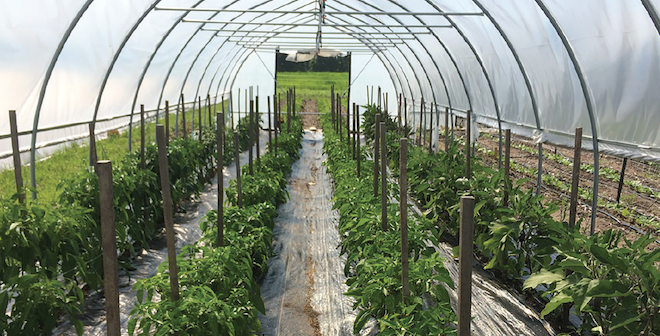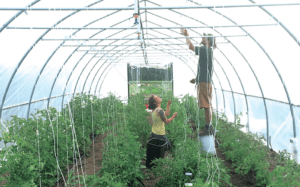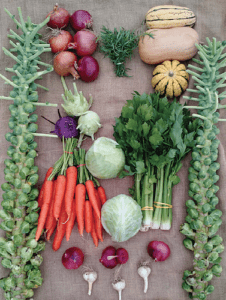
Feb 19, 2020Hoop house soil, tissue testing and pH check pay off
Hoop houses put many crops side-by-side with different nutrient needs – all of them grown without the cleansing effect of rainwater. How do you know if they’re all getting the nutrients they need?
“We soil test every fall and ideally we test before putting in crops to overwinter,” said Rachel Cross, owner and farm manager of Spirit of Walloon Market Garden of Boyne City, Michigan. “We can do a separate test for plant available nitrogen in the spring,” Cross said. “If we’re seeing a new problem, or aren’t sure what we’re seeing, we get a tissue test.”
Cross was a speaker at the recent Great Lakes Fruit, Vegetable and Farm Market EXPO in Grand Rapids, Michigan.

“Anytime you can dial in on what you’re doing, I’d recommend you do it,” Cross said. “If you can’t measure it, you can’t manage it.”
The Spirit of Walloon Market Garden has four moveable hoop houses and one larger hoop house. It has the sandy soils that are common along the west shoreline of Lake Michigan and is named after the nearby Walloon Lake. The operation grows close to 40 different crops including strawberries and many vegetables, herbs and cut flowers.
“We are not certified organic but follow organic practices,” Cross said. Cover crops, compost, crop rotation and minimal tillage are all part of the management mix.
Soil pH is a concern. “This is a big one in hoop houses because you’re not having rainwater come in,” Cross said.
“You’re relying on well water or some other type of water for irrigation.” The Spirit of Walloon Market Garden irrigates out of an aquifer that tends toward alkaline. “Every time we irrigate, we’re applying a little bit of lime,” Cross said.
In one situation, soil tests were showing a very adequate amount of available potassium, yet a tissue test confirmed a potassium deficiency. “We found our soil pH was slowly creeping up,” Cross said. That meant applying elemental sulphur.

Compost plays a role
Cross uses the Purdue University publication “Lowering Soil pH for Horticulture Crops” as a guide.
“Managing pH is hard with so many different crops,” Cross said. The guide is available at www.extension.purdue.edu/extmedia/ho/ho-241-w.pdf.
A number of nitrogen sources are used at the Spirit of Walloon Market Garden. The rate of release, ease of application and cost are all considerations.
Compost is a key component to promote nitrogen release from nutrient cycling. “You want composts that are really easy for microbes to break down and that help build up their numbers,” Cross said. “We stock a number of products and apply a little of everything.”

Salad crops are sometimes left to grow in the hoop houses as a way to add compost. “Let kale green up after three cuttings, then mow it down and work in the organic matter,” Cross said. “This can work – if you have the time and space.” The farm has used cover crops to add organic matter but tends to use compost because of the space cover crops needs.
The key concept is to stack your nitrogen sources.
“We assume one-third of the nitrogen from composts is available in the first year,” Cross said. Estimate how much more nitrogen is being released from the organic matter and add in the amount applied as fertilizer. Pelletized feather meal is the main source of nitrogen fertilizer for soil applications and can be applied every two to three weeks if needed.
Then, factor in any nitrogen applied with split applications through drip irrigation. “For heavy feeders, we do split applications,” Cross said. “Tomatoes need lots of nitrogen.” The liquid fertilizer rate is calibrated per 100 feet of row which means you have to know how much water is being applied.
Landscape fabric is used if liquid fertilizer is going to be applied. “Fabric mesh helps manage moisture in the summer when it gets really hot,” Cross said. “Evaporation pulls a lot of nutrients out of the root zone.”
“We run overhead irrigation once a month and really have a big green up,” Cross said. The practice helps a lot on the sandy soils – even in areas already under drip irrigation. “We do it once a month in the early morning on a nice sunny day,” Cross said.
— Dean Peterson, VGN correspondent
















